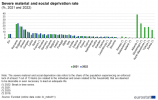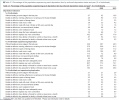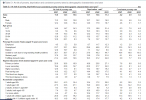Poverty across the EU is measured in several ways. The first way is AROP, which you could argue is more a measure of low incomes.
National median disposable income, SILC 2023, refers to calendar year 2022
At household level = 55,149
Equivalised per person = 27,597
(there are various ways to equivalise the household data, and that can make a difference)
We get 60% of the median, to determine the AROP threshold
AROP threshold = 0.60*27,597 = 16,558 thresholf for one adult
That is an AROP threshold of 317 per week.
For two adults and two children, the threshold is 38,415, or 736 per week
The SILC then counts how many people have disposable income less than 317 pw.
At risk of poverty rate
This is the share of persons with an equivalised income below a given percentage (usually 60%) of the national median income. It is also calculated at 40%, 50% and 70% for comparison. The rate is calculated by ranking persons by equivalised income from smallest to largest and then extracting the median or middle value. Anyone with an equivalised income of less than 60% of the median is considered at risk of poverty at a 60% level.National median disposable income, SILC 2023, refers to calendar year 2022
At household level = 55,149
Equivalised per person = 27,597
(there are various ways to equivalise the household data, and that can make a difference)
We get 60% of the median, to determine the AROP threshold
AROP threshold = 0.60*27,597 = 16,558 thresholf for one adult
That is an AROP threshold of 317 per week.
For two adults and two children, the threshold is 38,415, or 736 per week
The SILC then counts how many people have disposable income less than 317 pw.


